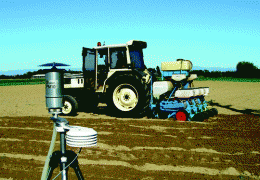Corn insecticide linked to great die-off of beneficial honeybees

New research has linked springtime die-offs of honeybees critical for pollinating food crops — part of the mysterious malady called colony collapse disorder — with technology for planting corn coated with insecticides. The study, published in ACS' journal Environmental Science & Technology, appears on the eve of spring planting seasons in some parts of Europe where farmers use the technology and widespread deaths of honeybees have occurred in the past.
In the study, Andrea Tapparo and colleagues explain that seeds coated with so-called neonicotinoid insecticides went into wide use in Europe in the late 1990s. The insecticides are among the most widely used in the world, popular because they kill insects by paralyzing nerves but have lower toxicity for other animals. Almost immediately, beekeepers observed large die-offs of bees that seemed to coincide with mid-March to May corn planting. Scientists thought this might be due to particles of insecticide made airborne by the pneumatic drilling machines used for planting. These machines forcefully suck seeds in and expel a burst of air containing high concentrations of particles of the insecticide coating. In an effort to make the pneumatic drilling method safer, the scientists tested different types of insecticide coatings and seeding methods.
They found, however, that all of the variations in seed coatings and planting methods killed honeybees that flew through the emission cloud of the seeding machine. One machine modified with a deflector to send the insecticide-laced air downwards still caused the death of more than 200 bees foraging in the field. The authors suggest that future work on this problem should focus on a way to prevent the seeds from fragmenting inside the pneumatic drilling machines.
More information: Assessment of the Environmental Exposure of Honeybees to Particulate Matter Containing Neonicotinoid Insecticides Coming from Corn Coated Seeds, Environ. Sci. Technol., 2012, 46 (5), pp 2592–2599. DOI: 10.1021/es2035152
Abstract
Since seed coating with neonicotinoid insecticides was introduced in the late 1990s, European beekeepers have reported severe colony losses in the period of corn sowing (spring). As a consequence, seed-coating neonicotinoid insecticides that are used worldwide on corn crops have been blamed for honeybee decline. In view of the currently increasing crop production, and also of corn as a renewable energy source, the correct use of these insecticides within sustainable agriculture is a cause of concern. In this paper, a probable—but so far underestimated—route of environmental exposure of honeybees to and intoxication with neonicotinoid insecticides, namely, the atmospheric emission of particulate matter containing the insecticide by drilling machines, has been quantitatively studied. Using optimized analytical procedures, quantitative measurements of both the emitted particulate and the consequent direct contamination of single bees approaching the drilling machine during the foraging activity have been determined. Experimental results show that the environmental release of particles containing neonicotinoids can produce high exposure levels for bees, with lethal effects compatible with colony losses phenomena observed by beekeepers.
Provided by American Chemical Society

















